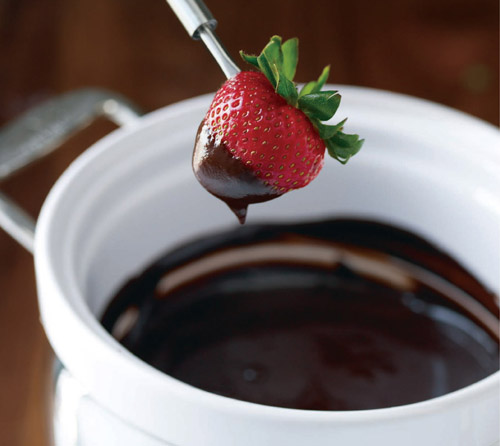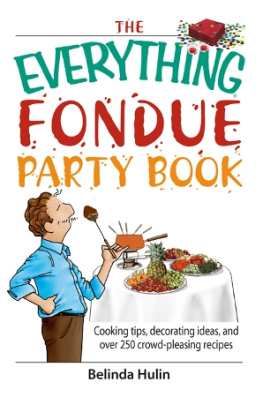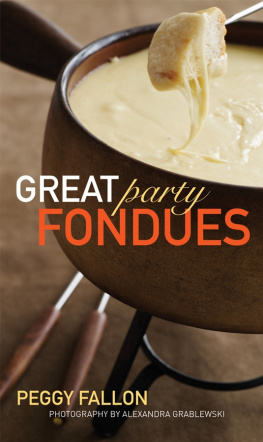fondue
sweet & savory recipes for gathering around the table
recipes Bob & Coleen Simmons
photographs Alex Farnum



fondue for the modern table
Nowadays, many of us no longer take the time to gather together around the dining table. But fondue promises to change that. An iconic party dish of days gone by, fondue has recently staged a comeback, and busy cooks are discovering that this time-honored communal dish is an easy, fun way to reconnect with family and friends.
Cheese fondue has been eaten in Switzerland for centuries, but it wasnt until the 1960s and 1970s that it became a popular party dish in the United States. The traditional oil fondues of France and broth-based meat and seafood hot pots of Asia arrived on American tables not long after. Like many of our favorite dishes, these communal pots have humble origins, often sustaining peasant families through hard times. Today, they are viewed as creative, festive ways to entertain.
Included in this book are recipes for some of the best-known fondues and hot pots, like .
With the proper equipment and the highest-quality ingredients, fondues can be among the easiest and most successful dishes to cook for weekday suppers or company dinners, and youll find tips on choosing both in the following chapters. Also, preparing your own dippers will add a special touch to your meals. to discover fast, tasty recipes for homemade Tortilla Chips, Grilled Apples, Polenta Cubes, Churros, Sugar Twists, Caramel Corn Clusters, and more. And no matter which fondues and dippers you serve, your communal-pot meals are guaranteed to delight everyone at the table.

cheese fondues
about cheese fondues
about cheese fondues
Centuries ago, the Swiss discovered that the cheeses they made and stored in warmer months hardened over time, making them good candidates for melting and eating with chunks of dried bread during winter. Today, that classic combination has expanded to include a wide variety of imported and domestic cheeses and wines and myriad dippers.
equipment
You can use almost any type of fondue pot to serve a cheese fondue. Traditionally, it is made in a heavy, wide earthenware pot called a caquelon, which retains heat well, resists scorching, and is broad enough to make dipping easy. A less traditional option is a specialized metal pot with a ceramic insert. While water simmers in the metal pot, the cheese mixture cooks gently inthe insert. Stainless-steel and enameled cast-iron pots are also good choices because they are durable, nonreactive, and hold heat well. Electric fondue pots have built-in, adjustable thermostats that allow you to make fondues right at the table.
Most fondue pots come with a stand for steadying the vessel securely above the heat source. Some stands are designed for use with a specific fuel type, so check the manufacturers directions for guidelines. Common fuels include gels such as Sterno, denatured alcohol, butane, or even tea lights. If you are using an electric pot, set it up near an outlet with the cord safely out of traffic.
ingredients
The best cheese fondues start with a good melting cheese. Any cheeses that dont melt well on their own, such as smoked Gouda or some processed cheeses, wont melt well in a fondue. Tossing a little cornstarch with the cheese prevents clumping and helps thicken the fondue to a creamy consistency. A flavorful acidic ingredient, such as dry white wine, gives the fondue depth, helps keep it creamy and smooth, and prevents it from scorching. Beer, hard cider, or fresh citrus juice can be used in place of the wine. These ingredients are the basics. Beyond them is a pantryful of herbs, spices, aromatics, such as garlic, onion, and chile, and liqueursincluding the traditional cherry-flavored kirschthat can be used to flavor cheese fondues.
Crusty dippers, from bread cubes, pita crisps, and tortilla chips to cubes of fried polenta, are ideal for swirling in cheese fondue. Although raw vegetables are tasty in salads, most of them should be briefly cooked (blanched) in salted water until for dipping into fondue. Other flavorful dippers include pieces of warmed cooked potato or sausage.
 good melting cheeses...
good melting cheeses...
Swiss-style cheeses such as Gruyre & Emmentaler
Blue cheeses such as Roquefort & Maytag blue
Soft-ripened cheeses such as Teleme, Brie & Camembert
Semi-soft cheeses such as Jack, Havarti & mozzarella
Semi-hard cheeses such as Cheddar, Edam & Manchego
cooking & serving
Cheese fondue is surprisingly easy to make. It can be prepared in a saucepan on the stove top and then transferred to a fondue pot for serving, or you can make it in an electric fondue pot at the table. Before you cut up or shred the cheese, always remove and discard any hard rinds or any soft exterior molds, such as those on Brie or Camembert, or your fondue will not be smooth. Then cut or shred the cheese finely, especially a hard cheese, so it will melt evenly.
When it is time to eat, invite diners to spear their dipper of choice onto the end of a fondue fork and plunge it into the communal pot of molten cheese. Tradition calls for stirring the cheese in a figure-eight motion across the bottom of the pot to both coat the dipper thoroughly and stir the cheese mixture. The cheese-coated morsel is then transferred to a plate, slipped free of the fondue fork, and eaten with a table fork. If the fondue becomes too thick or stringy during serving, thin it slightly by stirring in a tablespoon or two of the liquid used in the recipe.
 fondue rituals...
fondue rituals...
Fondue customs vary from household to household. One of the more popular traditions holds that if a diner drops a cube of bread into the fondue, he or she must kiss the person seated to his or her left.

classic swiss fondue
Emmentaler cheese , lb, cut into -inch cubes
Gruyre cheese , lb, cut into -inch cubes
cornstarch , 1 tbsp
garlic , 1 clove, halved lengthwise
dry white wine such as Alsatian Riesling or Sauvignon Blanc , 1 cups
kirsch or brandy , 2 tbsp (optional)
fresh lemon juice , 1 tbsp
freshly grated nutmeg , pinch
Kosher salt
Accompaniments of your choice (bottom right)
In a bowl, toss the Emmentaler and Gruyre cheeses with the cornstarch and set aside.
Rub the inside of a with the cut sides of the garlic halves; discard the garlic. Pour the wine, kirsch (if using), and lemon juice into the pot and bring to a simmer over medium-low heat. Gradually add the cheeses, a handful at a time, and stir gently until the mixture is creamy and the cheeses are completely melted. Stir in the nutmeg. Taste and adjust the seasonings, adding a little salt if needed.

















 good melting cheeses...
good melting cheeses...